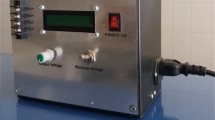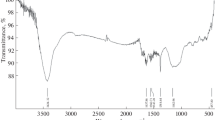Abstract
The authors show that carbon fiber bundles electrochemically modified with the conducting polymer poly(3,4-ethylenedioxythiophene) (PEDOT) is a viable sorbent for online solid-phase microextraction (SPME) of the sulfonamides (sulfadiazine, sulfadimidine and sulfamethoxazole) prior to their determination by HPLC. The fibers were packed in a tube loop made from polyether ether ketone (PEEK) that was coupled to the HPLC system for online SPME. Preconcentration factors can reach values of up to 300, and the limit of detection (at an S/N ration of 3) can be as low as 0.05 ng⋅mL−1. The method was applied to the analysis of the sulfonamides in spiked rat plasma with intra-day and inter-day RSDs of <3.33 and <4.57 %, and with recoveries in the range from 91.7 to 97.8 % in spiked plasma. The in-tube SPME was also applied to the determination of the 3 sulfonamides in rat plasma after oral administration (tablet powder) with high sensitivity. In addition to its efficient extraction, the PEEK tube based SPME has chemical and mechanical stability under even harsh conditions.

Electrochemically modified carbon fibers were packed into polyether ether ketone (PEEK) tube and connect with HPLC system. Good stability and extraction efficiency over 300 fold have been obtained. Application in plasma samples exhibits high extraction efficiency, good reproducibility and recoveries.





Similar content being viewed by others
References
Huang WS, Humphrey BD, MacDiarmid AG (1986) Polyaniline, a novel conducting polymer. Morphology and chemistry of its oxidation and reduction in aqueous electrolytes. J Chem Soc Faraday Trans 82:2385
Huang JC (2002) Carbon black filled conducting polymers and polymer blends. Adv Polym Technol 21:299
Shirakawa H (2001) The discovery of polyacetylene film: the dawning of an era of conducting polymers (Nobel lecture). Angew Chem-Int Ed 40:2574
Snook GA, Kao P, Best AS (2011) Conducting-polymer-based supercapacitor devices and electrodes. J Power Sources 196:1
Kreuer KD (2001) On the development of proton conducting polymer membranes for hydrogen and methanol fuel cells. J Membr Sci 185:29
Gerard M, Chaubey A, Malhotra BD (2002) Application of conducting polymers to biosensors. Biosens Bioelectron 17:345
Xia L, Wei Z, Wan M (2010) Conducting polymer nanostructures and their application in biosensors. J Colloid Interface Sci 341:1
Collins CJ, Arrigan DW (2009) A review of recent advances in electrochemically modulated extraction methods. Anal Bioanal Chem 393:835
Abdolmohammad-Zadeh H, Rezvani Z, Sadeghi GH et al (2011) Layered double hydroxides: a novel nano-sorbent for solid-phase extraction. Anal Chim Acta 685:212
Wei F, Fan J, Zheng MM et al (2010) Combining poly (methacrylic acid‐co‐ethylene glycol dimethacrylate) monolith microextraction and octadecyl phosphonic acid‐modified zirconia‐coated CEC with field‐enhanced sample injection for analysis of antidepressants in human plasma and urine. Electrophoresis 31:714
Ma Q, Chen M, Shi ZG et al (2009) Preparation of a poly (N‐isopropylacrylamide‐co‐ethylene dimethacrylate) monolithic capillary and its application for in‐tube solid‐phase microextrac‐tion coupled to high‐performance liquid chromatography. J Sep Sci 32:2592
Li X, Zhong M, Xu S et al (2006) Determination of phthalates in water samples using polyaniline-based solid-phase microextraction coupled with gas chromatography. J Chromatogr A 1135:101
Wu J, Pawliszyn J (2004) Solid-phase microextraction based on polypyrrole films with different counter ions. Anal Chim Acta 520:257
Li X, Li C, Chen J et al (2008) Polythiophene as a novel fiber coating for solid-phase microextraction. J Chromatogr A 1198:7
Banitaba MH, Mohammadi AA, Davarani SSH et al (2011) Preparation and evaluation of a novel solid-phase microextraction fiber based on poly (3, 4-ethylenedioxythiophene) for the analysis of OCPs in water. Anal Methods 3:2061
Wu M, Zhang H, Zhao F et al (2014) A novel poly (3, 4-ethylenedioxythiophene)-ionic liquid composite coating for the headspace solid-phase microextraction and gas chromatography determination of several alcohols in soft drinks. Anal Chim Acta 850:41
Ma Y, Zhao F, Zeng B (2013) Electrodeposition of poly (3, 4-ethylenedioxythiophene) on a stainless steel wire for solid phase microextraction and GC determination of some esters with high boiling points. Talanta 104:27
Hosseiny Davarani SS, Nojavan S, Asadi R et al (2013) Electro‐assisted solid‐phase microextraction based on poly (3, 4‐ethylenedioxythiophen) combined with GC for the quantification of tricyclic antidepressants. J Sep Sci 36:2315
Tian T, Zheng S, Ye B et al (2013) Poly-3, 4-ethylenedioxythiophene nanoclusters for high effective solid phase extraction. J Chromatogr A 1275:17
Yang N, Zoski CG (2006) Polymer films on electrodes: investigation of ion transport at poly (3, 4-ethylenedioxythiophene) films by scanning electrochemical microscopy. Langmuir 22:10338
Simonet J, Rault-Berthelot J (1991) Electrochemistry: a technique to form, to modify and to characterize organic conducting polymers. Prog Sol State Chem 21:1
Hernandez V, Ramirez FJ, Otero TF et al (1994) An interpretation of the vibrational spectra of insulating and electrically conducting poly (3‐methylthiophene) aided by a theoretical dynamical model. J Chem Phys 100:114
Martin DC, Wu J, Shaw CM et al (2010) The morphology of poly (3, 4-ethylenedioxythiophene). Polym Rev 50:340
Van Laar B, Ijdo DJW (1971) Preparation, crystal structure, and magnetic structure of LiCrS< sub> 2</sub> and LiVS< sub> 2</sub> J Solid State Chem 3:590
Tao Y, Liu JF, Hu XL et al (2009) Hollow fiber supported ionic liquid membrane microextraction for determination of sulfonamides in environmental water samples by high-performance liquid chromatography. J Chromatogr A 1216:6259
Lu KH, Chen CY, Lee MR (2007) Trace determination of sulfonamides residues in meat with a combination of solid-phase microextraction and liquid chromatography–mass spectrometry. Talanta 72:1082
Yu C, Hu B (2012) C 18-coated stir bar sorptive extraction combined with high performance liquid chromatography–electrospray tandem mass spectrometry for the analysis of sulfonamides in milk and milk powder. Talanta 90:77
Huang X, Qiu N, Yuan D (2009) Simple and sensitive monitoring of sulfonamide veterinary residues in milk by stir bar sorptive extraction based on monolithic material and high performance liquid chromatography analysis. J Chromatogr A 1216:8240
Deng Y, Liao Q, Li S et al (2008) Simultaneous determination of berberine, palmatine and jatrorrhizine by liquid chromatography–tandem mass spectrometry in rat plasma and its application in a pharmacokinetic study after oral administration of coptis–evodia herb couple. J Chromatogr B 863:195
Acknowledgments
This work was supported by the National Natural Science Foundation of China (Grant nos. 81573384, 21375101 and 91417301), and Natural Science Foundation of Hubei (No. 2014CFA077).
Author information
Authors and Affiliations
Corresponding author
Electronic supplementary material
Below is the link to the electronic supplementary material.
ESM 1
(DOCX 553 kb)
Rights and permissions
About this article
Cite this article
Ling, X., Zhang, W. & Chen, Z. Electrochemically modified carbon fiber bundles as selective sorbent for online solid-phase microextraction of sulfonamides. Microchim Acta 183, 813–820 (2016). https://doi.org/10.1007/s00604-015-1726-y
Received:
Accepted:
Published:
Issue Date:
DOI: https://doi.org/10.1007/s00604-015-1726-y




